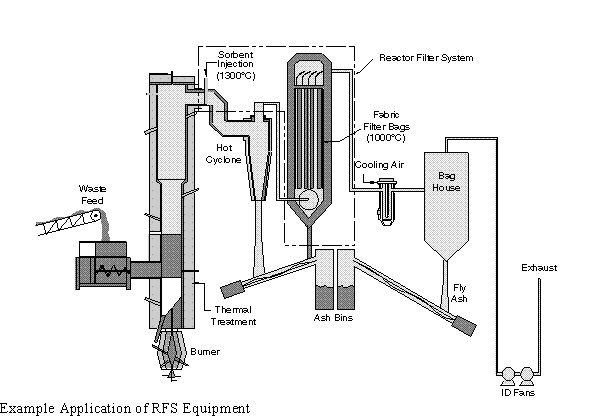
(Reactor Filter System)
The Energy and Environmental Research Corporation (EER) Reactor Filter System
(RFS) technology is designed to control gaseous and entrained particulate
matter emissions from the primary thermal treatment of sludges, soils, and
sediments. Most Superfund sites are contaminated with toxic organic chemicals
and metals. Currently available thermal treatment systems for detoxifying
these materials release products of incomplete combustion (PIC) and volatile
toxic metals. Also, the large air pollution control devices (APCD) often
required to control PICs and metals are generally not suitable for transport
to remote Superfund sites. EER designed the RFS to avoid some of these logistical
problems. The RFS uses a fabric filter installed immediately downstream of
the thermal treatment process to control toxic metals, particulates, and
unburned organic species. The RFS involves the following three steps:
The RFS may improve the performance of existing thermal treatment systems for Superfund wastes containing metals and organics. During incineration, hazardous organics are often attached to the particulate matter that escapes burning in the primary zone. The RFS provides sufficient residence time at sufficiently high temperatures to destroy such organics. Also, by increasing gas-solid contact parameters, the system can decrease metal emissions by preventing the release of metals as vapors or retained on entrained particles.
The figure shows the RFS installed immediately downstream of the primary thermal treatment zone at EER's Spouted Bed Combustion Facility. Because the spouted bed generates a highly particulate-laden gas stream, a high-temperature cyclone is used to remove coarse particulate matter upstream of the RFS. Sorbent is injected into the flue gas upstream of the high temperature fabric filter. A conventional baghouse is available for comparison with RFS performance during the demonstration. However, the baghouse is not needed in typical RFS applications since the high-temperature filtration medium has shown similar performance to conventional fabric filtration media.

The RFS is designed to remove entrained particulates, volatile toxic metals, and condensed-phase organics present in high-temperature (800 to 1,000 C) gas streams generated from the thermal treatment of contaminated soils, sludges, and sediments. Many conventional treatments can be combined with the RFS technology. Process residuals will consist of nonleachable particulates that are essentially free of organic compounds, thus reducing toxicity, handling risks, and landfill disposal.
The RFS was accepted into the Emerging Technology Program in 1993. EER developed the pilot-scale process through a series of bench-scale screening studies, which were completed in September 1994. These screening studies guided the sorbent selection and operating conditions for the pilot-scale demonstration. The tests were completed in 1996; the final report will be available from the National Technical Information Service.
EPA PROJECT MANAGER:
Steven Rock
U.S. EPA
National Risk Management Research Laboratory
26 West Martin Luther King Drive
Cincinnati, OH 45268
513-569-7149
Fax: 513-569-7105
TECHNOLOGY DEVELOPER CONTACT:
Neil Widmer
Energy and Environmental
Research Corporation
18 Mason Street
Irvine, CA 92718
714-859-8851
Fax: 714-859-3194